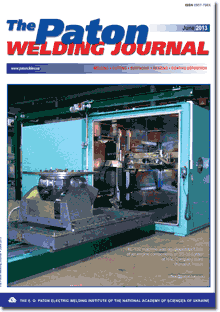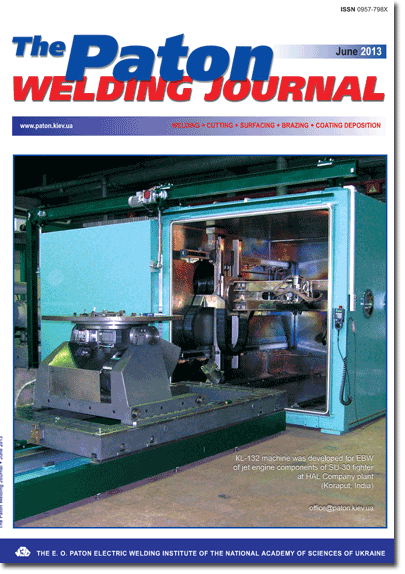| 2013 №06 (09) | 2013 №06 (02) |

The Paton Welding Journal, 2013, #6, 2-10 pages
Effect of non-metallic inclusions on formation of structure of the weld metal in high-strength low-alloy steels
V.V. Golovko, I.K. Pokhodnya
E.O. Paton Electric Welding Institute, NASU
Abstract
Investigated was the possibility of using the oxide metallurgy approaches providing for control of the amount, distribution and morphology of the inclusions in metal melts, which affect conditions for formation of microstructure of the weld metal. It was shown that increase in the content of the fine-grained secondary phase can be achieved by varying the content of the fine carbide phase in structure of the weld metal. A high density of distribution of the 0.3—1.0 ?m inclusions containing titanium or zirconium oxides leads to formation of the bainitic structure, whereas the decreased content of carbon in metal and narrowing of the range of bainitic transformations limit the probability of formation of the upper bainite microstructure. It was found that to provide the microstructure characterised by a combination of high values of strength, ductility and toughness it is necessary to form inclusions of a certain composition, size and distribution density in the weld metal. This can be achieved by using the oxide metallurgy methods, which provide for addition of a certain amount of refractory inclusions to the weld pool, limitation of its oxygen content and selection of the deoxidation system, as well as of the required temperature range of intermediate transformations based on the TTT-diagrams and welding thermal cycle. 12 Ref., 9 Tables, 13 Figures.
Keywords: welding, low-alloy steels, oxide metallurgy, welds, non-metallic inclusions, alloying, microstructure, mechanical properties
Received: 27.03.13
Published: 28.06.13
References
1. Fairchild, D.P., Macia, M.L. (2003) Girth welding development for X120 linepipe. In: Proc. of 13th Int. Offshore and Polar Engineering Conf. (Honolulu, Hawaii, 25—30 May, 2003), 26—35.
2. Dhua, S.K., Mukerjee, D., Sarma, D.S. (2002) Weldability and microstructural aspects of shielded metal arc welded HSLA-100 steel plates. ISIJ Int., 42(3), 290—298.
3. Grong, O., Kolbeinsen, L., van der Eijk, C. et al. (2006) Microstructure control of steels through dispersoid metallurgy using novel grain refining alloys. Ibid., 46, 824—831.
4. Takamura, J., Mizoguchi, S. (1990) Roles of oxides in steels performance – Metallurgy of oxides in steels. Ibid., 1, 591—597.
5. Lee, T.K., Kim, H.J., Kang, B.Y. et al. (2000) Effect of inclusion size on nucleation of acicular ferrite in welds. Ibid., 40(1), 1260—1268.
6. Pokhodnya, I.K., Golovko, V.V., Denisenko, A.V. et al. (1999) Effect of oxygen on formation of acicular ferrite in low-alloy weld metal (Review). Avtomatich. Svarka, 2, 3—10, 20.
7. Li, H.G., Zheng, S.B., Xie, S.J. et al. (2009) Influence of liquid steel cooling rate during directional solidification on titanium oxide precipitation. Ironmaking and Steelmaking, 36(1), 29—32.
8. Kikuchi, N., Nabeshima, S., Yamashita, T. et al. (2011) Microstructure refinement in low carbon high manganese steels through Ti-deoxidation, characterization and effect of secondary deoxidation particles. ISIJ Int., 51(12), 2019—2028.
9. Sarma, D.S., Karasev, A.V., Jonsson, P.G. (2009) On role of non-metallic inclusions in the nucleation of acicular ferrite in steels. Ibid., 46(6), 1063—1074.
10. Grigorenko, G.M., Golovko, V.V., Kostin, V.A. et al. (2005) Effect of microstructural factors on sensitivity of welds with ultra-low carbon content to brittle fracture. The Paton Welding J., 2, 2—10.
11. Golovko, V.V., Kostin, V.A., Grigorenko, G.M. (2011) Peculiarities of the influence of complex alloying on structure formation and mechanical properties of welds on low-alloyed high-strength steels. The Paton Welding J., 7, 11—17.
12. Keehan, E., Karlsson, L., Andren, H.-O. et al. (2006) New developments with C—Mn—Ni highstrength steel weld metals. Pt A: Microstructure. Welding J., 9, 200—210.
Suggested Citation
V.V. Golovko, I.K. Pokhodnya (2013) Effect of non-metallic inclusions on formation of structure of the weld metal in high-strength low-alloy steels. The Paton Welding J., 06, 2-10.The cost of subscription/purchase order journals or individual articles
| Journal/Currency | Annual Set | 1 issue printed |
1 issue |
one article |
| TPWJ/USD | 384 $ | 32 $ | 26 $ | 13 $ |
| TPWJ/EUR | 348 € | 29 € | 24 € | 12 € |
| TPWJ/UAH | 7200 UAH | 600 UAH | 600 UAH | 280 UAH |
| AS/UAH | 1800 UAH | 300 UAH | 300 UAH | 150 UAH |
| AS/USD | 192 $ | 32 $ | 26 $ | 13 $ |
| AS/EUR | 180 € | 30 € | 25 € | 12 € |
| SEM/UAH | 1200 UAH | 300 UAH | 300 UAH | 150 UAH |
| SEM/USD | 128 $ | 32 $ | 26 $ | 13 $ |
| SEM/EUR | 120 € | 30 € | 25 € | 12 € |
| TDNK/UAH | 1200 UAH | 300 UAH | 300 UAH | 150 UAH |
| TDNK/USD | 128 $ | 32 $ | 26 $ | 13 $ |
| TDNK/EUR | 120 € | 30 € | 25 € | 15 € |
AS = «Automatic Welding» - 6 issues per year;
TPWJ = «PATON WELDING JOURNAL» - 12 issues per year;
SEM = «Electrometallurgy Today» - 4 issues per year;
TDNK = «Technical Diagnostics and Non-Destructive Testing» - 4 issues per year.


